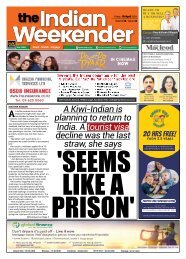The Indian Weekender, 11 June 2021
Weekly Kiwi-Indian publication printed and distributed free every Friday in Auckland, New Zealand
Weekly Kiwi-Indian publication printed and distributed free every Friday in Auckland, New Zealand
Create successful ePaper yourself
Turn your PDF publications into a flip-book with our unique Google optimized e-Paper software.
Thought of the week<br />
“<strong>The</strong> quality of a person’s life is in direct proportion<br />
to their commitment to excellence, regardless of<br />
their chosen field of endeavor.” — Vince Lombardi<br />
Editorial<br />
<strong>The</strong> sun finally shines<br />
on <strong>Indian</strong> women’s<br />
cricket<br />
Women have been playing cricket since 1745. Unfortunately, the gentlemen of the game<br />
never gave women’s cricket prominence and importance, and so it remained a village<br />
entertainment. In the late 19th and early 20th century in England, Australia, New Zealand<br />
and South Africa, there emerged a movement to establish women’s cricket.<br />
In 1926, a women’s cricket association was founded. It was only in 1958 that the International<br />
Women’s Cricket Council was formed to coordinate cricket around the world.<br />
In India, the efforts of just one man who selflessly pioneered the formation of the Women’s<br />
Cricket Association of India in 1973 has now borne fruit because of his vision and belief. Mahendra<br />
Kumar Sharma, a young cricket enthusiast from Lucknow, finally put women’s cricket on the <strong>Indian</strong><br />
map. He conducted the first ever national tournament amongst only three teams -- Maharashtra,<br />
Mumbai, and Uttar Pradesh -- in Pune.<br />
Preceding that his marketing efforts to get 200 spectators to watch the games in Lucknow and<br />
also his efforts in popularising women’s cricket should be recognised in the annals of <strong>Indian</strong> cricket<br />
history. With very limited financial resources at his beck and call, he went around the streets of<br />
Lucknow in a cycle rickshaw broadcasting the first ever match to be played by women at the<br />
Queen’s Anglo Sanskrit College. Sharma’s efforts bore fruit as women from other associations also<br />
joined in taking the game to several parts of the country.<br />
<strong>The</strong> first national camp at National Institute of Sports for women was held in Patiala. Legendary<br />
cricketer Lala Amarnath took the onus of supervising it. <strong>The</strong> women could not have had a better<br />
coach and mentor than him. Amarnath’s immense knowledge of the game and his strict regime<br />
turned the girls into a cricketing unit. He taught them the nuances of the game and the seed that he<br />
sowed has now blossomed into a fruitful entity.<br />
It was only in 2006, when the Board of Control for Cricket in India (BCCI) finally accepted<br />
to recognise women’s cricket. Until then they had several ups and downs. Finance was always a<br />
constraint and so they depended on the generosity of well-wishers and corporate sponsorships. <strong>The</strong><br />
<strong>Indian</strong> Railway, public limited banks, and <strong>Indian</strong> Airlines played a major part in encouraging and<br />
boosting women’s cricket. <strong>The</strong> railway, however, is still the major supporter of the women’s game.<br />
<strong>The</strong> sunshine days of women’s cricket have finally come to roost. A tour to England next month<br />
followed by a visit to Australia was just a dream come true for them. Having just played 36 Test<br />
matches in all these years, playing another in Bristol, England, from <strong>June</strong> 16 and a day-night Test<br />
from September 30 in Sydney will be a challenge.<br />
India last played a Test match way back in 2014 against England in Wormsley and beat the host.<br />
India were led astutely by Mithali Raj, who is still at the helm when India play England next month.<br />
Unfortunately, women’s Test cricket has not been the prime agenda of the ICC. <strong>The</strong> format is not,<br />
according to them, a commercially viable option and so the ODIs and the T20s are what they have<br />
focused on. <strong>The</strong> conventional form of cricket needs to be encouraged. If money is the be-all and<br />
end-all of keeping a sport alive, then men’s Test matches may also become unimportant.<br />
<strong>The</strong> <strong>Indian</strong> women’s team is a bunch of very talented cricketers. <strong>The</strong>y seem to have gone astray<br />
more with infighting and jealousy rather than their cricket. <strong>The</strong>re has been more chopping and<br />
changing of their coaches rather than the players. One gathers from several articles published that<br />
the senior players are warring amongst each other and their unhappiness with a coach is all it<br />
takes to replace him. Ramesh Powar, the recently appointed coach, has already had an open tiff<br />
with Mithali Raj, who will lead India in the only Test and the three ODIs in England. Both are<br />
professionals and so a truce, we hope, will soon be in the offing. However, the past could catch up if<br />
things do not go their way. Powar’s first task would be to get the captain and her teammates together<br />
believing in the one word that is so important to get harmony -- trust.<br />
<strong>The</strong> <strong>Indian</strong> women’s team reminds one of the <strong>Indian</strong> men’s team of the early 2000s. <strong>The</strong> stylish<br />
Smriti Mandhana is as graceful as Rohit Sharma and a hard hitter like Yuvraj Singh. Young Shafali<br />
Verma is in the same mould as Virender Sehwag while Jemimah Rodrigues and Poonam Raut have<br />
the ability to play their game in the way Rahul Dravid approached it.<br />
Mithali has proven to be the Sachin Tendulkar of women’s cricket. Since she is close to the end<br />
of her career, she can be the aspiring star for young women cricketers. <strong>The</strong> cricketing brilliance of<br />
Harmanpreet Kaur puts her as the most destructive batter in the team. <strong>The</strong> unbeaten 171-run innings<br />
that she played in a World Cup semi-final match against Australia in 2017 will be remembered<br />
as the best innings ever played by an <strong>Indian</strong> woman. She along with Deepti Sharma are the allrounders<br />
that India will depend on immensely.<br />
Tania Bhatia, back as the wicketkeeper, is a live wire behind the sticks and with the evergreen<br />
Jhulam Goswami to spearhead the pace bowling, the duo should complement one another in the<br />
pace friendly English conditions that most likely will prevail.<br />
Spin bowling is an area that the <strong>Indian</strong> team needs to take a relook at, especially the leg-spin of<br />
Poonam Yadav. Teams have analysed her to a fair degree and, therefore, she will need to mix her<br />
deliveries to surprise her opponent.<br />
<strong>The</strong> two weakest links in <strong>Indian</strong> women’s cricket is the fielding and their mental state when put<br />
against the wall. Fitness, agility, and a safe pair of hands are the areas that they can practice in the<br />
bio-secure bubble, however, they need to get not just physically fit, but also mentally.<br />
With both the men’s and the women’s team in the bubble, some good interaction between the two<br />
squads would be extremely helpful, especially to the women, to build and learn how to approach<br />
the highs and lows of the game.<br />
Embarking on a cricket journey to two of the top playing countries is sunshine for women’s<br />
cricket. One can already see a wonderful rainbow at the end of it. All the best to women in blue!<br />
<strong>Indian</strong> <strong>Weekender</strong> : Volume 13 Issue 13<br />
Publisher: Kiwi Media Publishing Limited<br />
Content Editor: Sandeep Singh | sandeep@indianweekender.co.nz<br />
Chief Technical Officer: Rohan deSouza | rohan@indianweekender.co.nz<br />
Graphic Designer: Yashmin Chand | design@indianweekender.co.nz<br />
Accounts and Admin.: 09-2173623 | accounts@indianweekender.co.nz<br />
Media Sales Manager.: Leena Pal: 021 952 216 | leena@indianweekender.co.nz<br />
Sales and Distribution: 021 952218 | sales@indianweekender.co.nz<br />
Editor at Large: Dev Nadkarni | dev@indianweekender.co.nz<br />
Views expressed in the publication are not necessarily of the publisher and the publisher<br />
is not responsible for advertisers’ claims as appearing in the publication<br />
Views expressed in the articles are solely of the authors and do not in any way represent<br />
the views of the team at the <strong>Indian</strong> <strong>Weekender</strong><br />
Kiwi Media Publishing Limited - 133A, Level 1, Onehunga Mall, Onehunga, Auckland.<br />
Printed at Horton Media, Auckland<br />
<strong>11</strong> <strong>June</strong> – 17 <strong>June</strong> <strong>2021</strong><br />
Fri Sat Sun Mon Tues Wed Thu<br />
On-and-off<br />
rain and<br />
drizzle<br />
22°<br />
15°<br />
On-and-off<br />
rain and<br />
drizzle<br />
19°<br />
13°<br />
Clouds<br />
and<br />
sun<br />
19°<br />
14°<br />
Clouds<br />
and<br />
sun<br />
20°<br />
14°<br />
Clouds<br />
and<br />
showers<br />
This week in New Zealand’s history<br />
<strong>11</strong> <strong>June</strong> 1901<br />
Cornwall Park gifted to Auckland<br />
20°<br />
14°<br />
Copyright 2020. Kiwi Media Publishing Limited. All Rights Reserved.<br />
A few<br />
morning<br />
showers<br />
21°<br />
15°<br />
A few<br />
morning<br />
showers<br />
26°<br />
17°<br />
At a civic reception for the Duke and Duchess of Cornwall and York, John Logan Campbell<br />
handed over the deed to land around One Tree Hill/Maungakiekie. <strong>The</strong> new park was<br />
named in honour of the royal couple.<br />
12 <strong>June</strong> 1902|<br />
New Zealand flag confirmed<br />
Following the news of royal<br />
assent to the New Zealand<br />
Ensign Act 1901, the New Zealand<br />
blue ensign that had been adopted<br />
for use on government ships in<br />
1869 (see 23 October 1869) was<br />
proclaimed as ‘the recognised<br />
flag of the colony for general use<br />
on shore within the colony and<br />
on all vessels belonging to the<br />
Government of New Zealand’.<br />
12 <strong>June</strong> 1942<br />
First US troops arrive in Auckland<br />
Over the following two years, about 100,000 American servicemen would spend time in<br />
New Zealand, which became a rear base for the Allies’ counter-offensive against Japan.<br />
This American ‘invasion’ led to a considerable clash of cultures<br />
14 <strong>June</strong> 1984<br />
Muldoon calls snap election<br />
Prime Minister Robert Muldoon surprised many by announcing a ‘snap’ election to be<br />
held in exactly one month’s time. He hoped to catch the opposition Labour Party underprepared,<br />
but the gamble backfired and National suffered a heavy defeat.<br />
15 <strong>June</strong> 1959<br />
Chinese gooseberry becomes<br />
kiwifruit<br />
<strong>The</strong> prominent produce company Turners and<br />
Growers announced that it would from now<br />
on export Chinese gooseberries as ‘kiwifruit’.<br />
Introduced to this country in 1904, kiwifruit are now<br />
cultivated worldwide, with New Zealand-grown<br />
fruit marketed as ‘Zespri’.


















